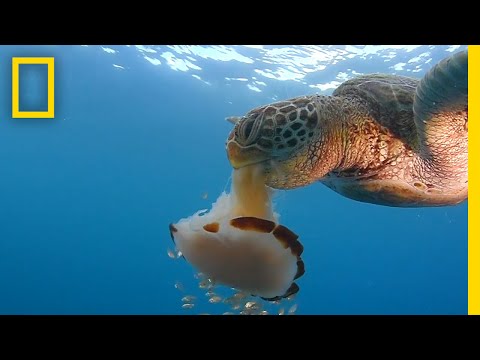Do green sea turtles eat jellyfish? The answer is yes; green sea turtles do eat jellyfish as their main source of food once they reach adulthood.
While young green sea turtles have a varied diet including plants and small invertebrates, mature turtles switch to feeding almost exclusively on jellyfish and other gelatinous creatures.
Their specialized adaptations, including strong jaws, speedy flippers, and leathery mouths, allow them to seek out and consume jellyfish safely and efficiently.
So these fascinating reptiles could undoubtedly be called jellyfish connoisseurs of the ocean!
This article explores why jellyfish make an ideal meal for green sea turtles, what types they prefer, the risks posed, and how they manage to feast on these slippery, stinging creatures.

What Do Green Sea Turtles Eat?
When it comes to green sea turtle’s diet, jellyfish are definitely on the menu. Green sea turtles are jellyfish connoisseurs and tend to favor these gelatinous invertebrates over other food sources.
As juveniles, green sea turtles eat a wide variety of plants and animals, including algae, seagrasses, crabs, sponges, and shrimp. However, as the turtles mature, they transition to specializing in particular jellyfish and other gelatinous species.
Adult green sea turtles feed almost exclusively on jellyfish and other gelatinous creatures like salps, sea jellies, and comb jellies. The jelly-based diet gives their fat a unique green color, hence the turtle’s name.
So in short – yes, definitely! Jellyfish make up the bulk of the diet for adult green sea turtles.
Why Do Green Sea Turtles Love to Eat Jellyfish?
There are a few key reasons why jellyfish make an ideal meal for green sea turtles:
Abundant Food Source
Jellyfish tend to travel in large blooms or swarms, which gives turtles access to plenty of food all in one place. Even when jellyfish numbers are low, green sea turtles can still locate them quickly due to their excellent sense of vision and smell.
Nutritional Value
While they seem like they would mostly be water, jellyfish actually provide good nutritional value for green sea turtles. They contain proteins, fats, carbohydrates, and even some minerals like sodium and calcium, which are essential for marine reptiles.
Low Calories Allow Turtles to Conserve Energy
Because jellyfish are over 95% water, they are very low in calories. This allows green sea turtles to fulfill their nutritional needs without expending a ton of energy searching for and capturing food. Conserving energy is crucial for their long annual migrations.
So, while jellyfish appear an odd food choice to us humans, they are perfectly adapted to provide nourishment for green sea turtles!
Green sea turtles love noshing on these gelatinous creatures due to their abundance, nutritional value and energysaving qualities!
What Types of Jellyfish Do Green Sea Turtles Prefer?
Green sea turtles feed on a variety of jellyfish species, but they do show preferences for certain types:
Moon Jellyfish
These translucent white jellyfish pulse through the water in large groups, making them an easy feast for hungry sea turtles. Their mild sting also doesn’t bother the turtles!
Blue Buttons
While the blue button’s stinger can paralyze fish and invertebrates, green sea turtles munch through these jellyfish unfazed. Their leathery shells and mouths allow them to consume stingers safely.
Mushroom Jellyfish
Ranging in size from a few inches to over three feet wide, mushroom jellyfish make quite a meal. Green sea turtles will deflate the jellyfish’s float with their jaws to make them easier to swallow.
Lion’s Mane Jellyfish
While most jellyfish sting their prey, the auxiliary mouths on lion’s mane tentacles actually deliver venom. Luckily, green sea turtles are unaffected by the venom and happily consume these giants.
Green sea turtles favor milder jellyfish species, but also handle more venomous lion’s mane jellyfish – their specialized bodies protect them from stings and venom!
Are There Any Risks from Eating Jellyfish?
Eating jellyfish does pose some minimal risks for green sea turtles:
Plastic Ingestion
Jellyfish often eat tiny pieces of plastic, which then transfer to sea turtles’ bodies when they consume the jellyfish. Over time, this plastic can accumulate.
Nutritional Imbalances
If green sea turtles eat too many low-calorie jellyfish rather than a balanced diet, it can lead to deficiencies or starvation. Their specialized adaptations make this rare, though.
Invasive Jellyfish Stings
Invasive species of more venomous jellyfish can cause painful stings inside the turtles if they eat them. This may inhibit feeding and cause illness.
Displacement from Prime Feeding Sites
Areas dense with nutritious, native jellyfish species often provide habitat for juvenile green sea turtles. Invasive jellyfish blooms displace and reduce essential food sources.
While jellyfish pose a low risk overall, invasive species and plastic pollution threaten the balance between green sea turtles and their favorite prey.
How Do Green Sea Turtles Hunt and Eat Jellyfish?
Green sea turtles have specialized adaptations that allow them to hunt, catch, and eat jellyfish:
Strong Sense of Sight and Smell
They have excellent underwater vision and olfaction that allows them to hone in on blooms of their gelatinous prey, even from a distance.
Swift Swimming
Powerful front flippers enable quick acceleration bursts to pursue fleeing individual jellyfish.
Sharp-Edged Jaws
Serrated edges on their jaws help grip slippery jellyfish. Their jaws then crush through the jellyfish that float in just a few bites.
Leathery Mouth and Esophagus
This allows green sea turtles to consume jellyfish stingers safely without harm.
Specialized adaptations like keen senses, speedy flippers, strong jaws and protected mouths all aid green sea turtles in seeking out and consuming nutrient-rich jellyfish.
Conclusion
In conclusion, green sea turtles, in fact, eat jellyfish as adults. These reptiles have evolved excellent sensory capabilities, physical features, and feeding behaviors to allow them to thrive on a Medusa-based diet.
While jellyfish pose a few minor risks, their abundance and nutritional value outweigh any concerns.
So, these shelled jellyfish connoisseurs will likely continue ambushing blooms of their gelatinous prey for millions of years to come!

